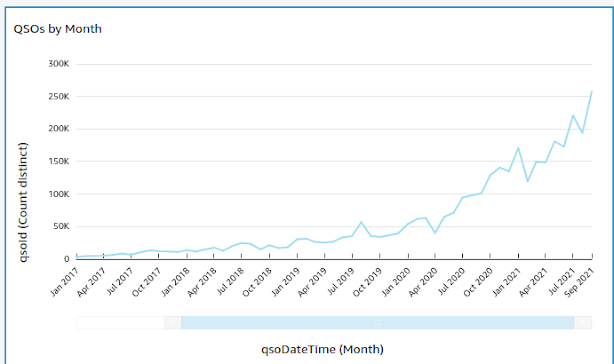Learning the Code
I hear fellow hams from time to time expressing frustration over not being able to pick up on CW. I get it. Learning CW is a bit like learning a new language, and that's not an easy thing to do. The CW requirement, long since dropped, is one of the first barriers that stopped me from becoming a licensed amateur back in my SWL days. I now consider CW to be one of the most enjoyable things about amateur radio. Here's how it happened.
There are a couple things to get out of the way before beginning this discussion. First, my CW proficiency is a work in progress. I'm not First Class Operator material by a long ways, and I still have a lot to learn. Secondly, there are a number of organizations, like the Long Island CW Club and the CW Academy, who provide structured courses for learning CW. These organizations have long lists of alumni with solid fists and solid copying skills. If you're considering taking one of these courses, nothing in this post should dissuade you from at least giving it a try. Presented here is what worked for me.
My wife and I both took French in college, and then spent over a quarter of a century not getting many chances to use it. We spent our twenty-fifth wedding anniversary in Paris, and were surprised to find out how quickly our college French came back to us. There may have been some awkward phraseology here or there, and there may have been a couple nouns that got the wrong gender, but we were able see sights and get around and buy things without ever once having to say, "Hey! Do you speak English?" And then one night, after a day of wine tasting in Burgundy, we found ourselves on a high-speed TGV train from Dijon back to Paris. About halfway home, the train lost all power and coasted to a stop with no heat, no public address announcements, and only emergency lighting. After a half hour of sitting in the dark and the cold of a December night in the French countryside, the conductor walked into our car and made what must have been the same announcement she was making in person in every car. The announcement was in French and astonishingly, I understood every single word. The power lines were de-energized, we'd be stuck there for at least ninety minutes, and the company (to our conductor's obvious frustration) wasn't really giving the train crew much information.
I got good at French because I had to get good at French. Otherwise, we'd be sitting in the dark and the cold without having any idea of what was happening. It was the ultimate immersive language experience.
I took a similarly immersive approach to learning CW. As an SWL, I discovered maritime coast stations in the late '80s. These stations provided RTTY and CW services for handling ship-to-shore traffic. The coast stations all ran markers: a transmitter that sent the station's call sign and maybe a brief statement about what frequencies they were monitoring in CW on a continuous loop. The markers assisted radio operators aboard ship in selecting a coast station to handle their traffic. If the marker could be heard, it meant the station was staffed and ready for traffic, and that a propagation path existed between the ship and that particular coast station. Coast stations were located all over the world and at the peak of Solar Cycle 22, they were a great way for an SWL to bag a lot of DX in a short time. I recorded these markers on cassette tape, and then played them back and tried to transcribe them. I stopped, rewound, and replayed whenever I fell behind. I grew tired of all the stopping and rewinding, and in time I got better at copying CW without really even trying. Eventually, I could copy coast marker messages right off the air without recording.
Once I had my Technician license for about a year, I knew I wanted to get back to life below thirty megahertz. This was the late spring of 2020, just as the world was withdrawing into the COVID-19 quarantine. Opportunities to sit for the General exam looked like they were going to be a little dodgy, and the Tech CW portion of 40 meters looked like it was going to be the quickest path to HF.
Drawing on my experience with coast markers, I decided that engaging with actual on-air activities would be how I'd relearn Morse code. I started by using an SDR and its software to record QSOs on 40 meters, duplicating the rewind-replay technique that I'd used before. After a few weeks of this I felt confident enough to try a few tentative QSOs. I got really good at sending "PSE QRS", and missing a character would start a cascade of missed characters reminiscent of the I Love Lucy chocolate factory episode, but I was making contacts and improving with each QSO. Then I discovered contests. The prescribed exchange and the repetition made for a perfect opportunity to improve. I would find a station running a frequency, listen to the exchange a few times until I had solid copy, and then answer. At first it took several repetitions to get it all. Today I can usually copy everything, even from QRQ contesters, after two repetitions of the exchange. In time, I'm sure I'll get it all on the first go.
Everyone's learning style is a little different. As with my experience learning French, I found the sink-or-swim experience to be way to go. If you're thinking about learning CW, whether you take an approach similar to what I've described or find another way that suits you, I hope to meet you on the air. 73


Comments
Post a Comment